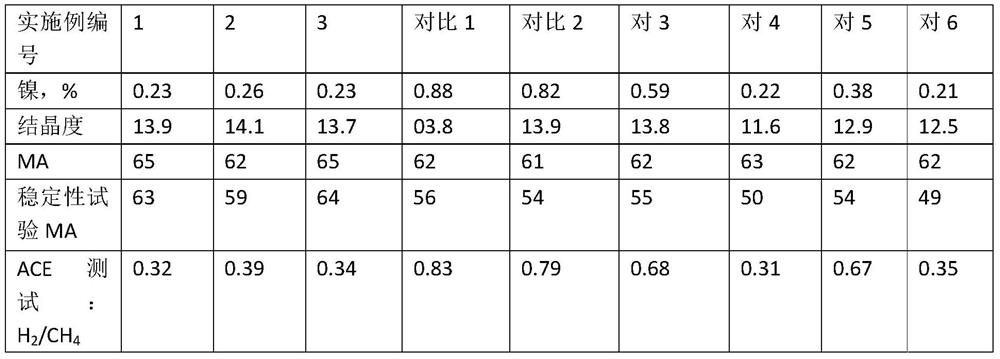Method for reactivating waste catalytic cracking catalyst
A technology for catalytic cracking and spent catalysts, applied in catalytic cracking, catalyst regeneration/reactivation, physical/chemical process catalysts, etc., can solve the problems of decreased activity and high acid strength, and achieve high activity stability, high retention, and reduced Effect of Hydrogen Yield and/or Coke Yield
- Summary
- Abstract
- Description
- Claims
- Application Information
AI Technical Summary
Problems solved by technology
Method used
Image
Examples
Embodiment approach
[0015] The method for revitalizing a spent catalytic cracking catalyst provided by the present invention, one embodiment, the silica mass fraction of the spent catalytic cracking catalyst is 30-75 mass%, the mass fraction of aluminum oxide is 20-65 mass%, and the rare earth metal The mass fraction is 0-5 mass%, and the nickel mass fraction is >0.4 mass%, such as 0.4-1.5 wt%. Preferably, the crystallinity of the spent catalytic cracking catalyst is ≥ 10%, such as ≥ 15%. The crystallinity can be analyzed with reference to SH / T 0340-1992 NaY molecular sieve crystallinity determination method. Preferably, the sum of the contents of vanadium and iron in the spent catalytic cracking catalyst is not higher than 0.6% by mass. In one embodiment, the content of polluted nickel in the spent catalytic cracking catalyst is significantly higher than the content of polluted vanadium and iron.
[0016] The method for revitalizing the spent catalytic cracking catalyst provided by the inventi...
Embodiment 1
[0034] Weighing 10 grams of spent catalytic cracking catalyst C1 was fluidized and roasted at 800°C for 3 hours in a hydrogen-helium atmosphere with a hydrogen content of 30% by volume to obtain reduced spent catalytic cracking catalyst HC1. Add 200ml NH to a 1L three-neck flask 3 and NH 4 + The total concentration of 8mol / L, NH 3 :CO 3 2 -Ammonia-ammonium carbonate solution with a mass ratio of 135:86, turn on the water bath to heat, and use a condenser to cool the volatile matter with tap water (temperature 16° C.), and reflux the condensate (hereinafter also referred to as condensing the volatile matter to reflux). Raise the temperature to 45° C., add 10 g of the reduced spent catalytic cracking catalyst HCl, and pass oxygen at 1 L / min for 30 min to perform the first contact. The pH throughout the first contacting process is 10.1-10.5. After filtering, the spent catalytic cracking catalyst after the first contact is obtained. The waste catalytic cracking catalyst aft...
Embodiment 2
[0038] Weighing 10 grams of spent catalytic cracking catalyst C1 was fluidized and roasted at 800°C for 3 hours in a hydrogen-helium atmosphere with a hydrogen content of 30% by volume to obtain reduced spent catalytic cracking catalyst HC2. Add 200ml NH to a 1L three-neck flask 3 and NH 4 + The total concentration of 8mol / L, NH 3 :CO 3 2 -Ammonia-ammonium carbonate solution with a mass ratio of 135:86, turn on the water bath to heat and use a condenser tube to condense and reflux the volatile substances. Raise the temperature to 45° C., add 10 g of the reduced spent catalytic cracking catalyst HC2, and pass oxygen at 1 L / min for 30 min to perform the first contact. The pH value of the whole first contact process is 10.1-10.5. After filtration, rinse twice with 100 ml of distilled water at room temperature to obtain the spent catalytic cracking catalyst after the first contact. Dry in a dryer at 150°C to obtain revived catalyst FC1-2.
[0039] The nickel mass fraction ...
PUM
 Login to View More
Login to View More Abstract
Description
Claims
Application Information
 Login to View More
Login to View More - R&D
- Intellectual Property
- Life Sciences
- Materials
- Tech Scout
- Unparalleled Data Quality
- Higher Quality Content
- 60% Fewer Hallucinations
Browse by: Latest US Patents, China's latest patents, Technical Efficacy Thesaurus, Application Domain, Technology Topic, Popular Technical Reports.
© 2025 PatSnap. All rights reserved.Legal|Privacy policy|Modern Slavery Act Transparency Statement|Sitemap|About US| Contact US: help@patsnap.com


